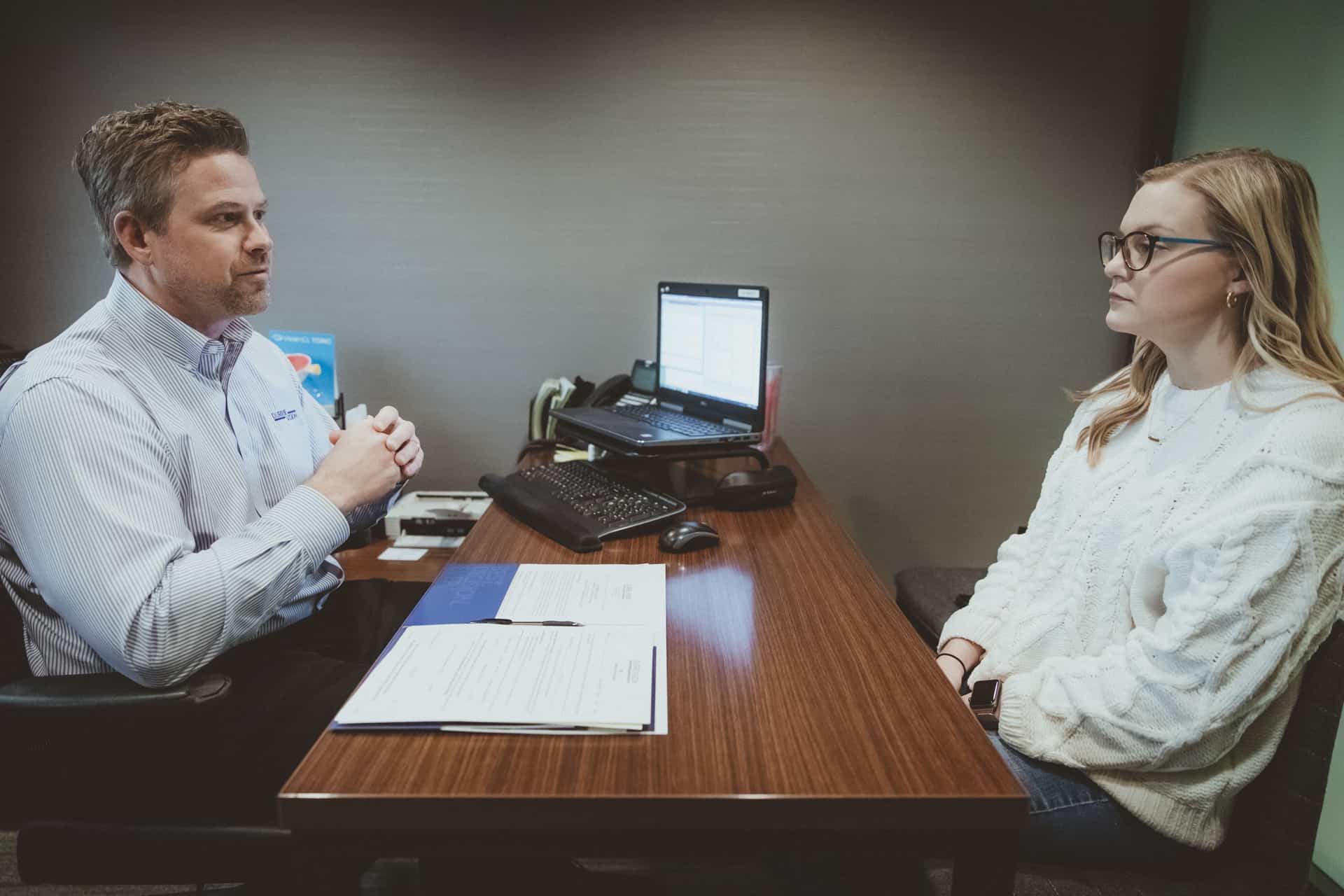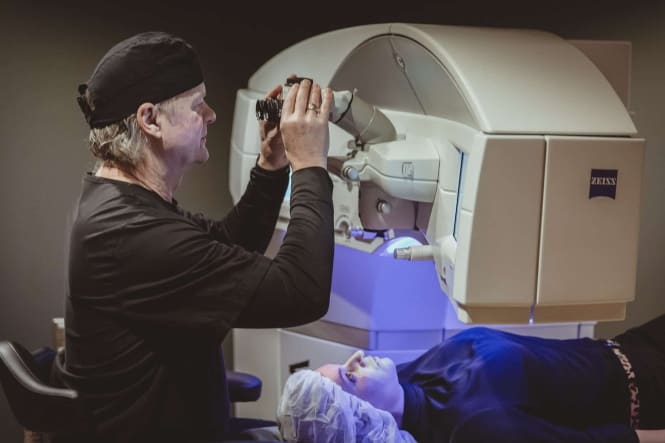If you suffer from nearsightedness, farsightedness, and/or astigmatism, you have several options to improve your vision including glasses, contacts, and laser vision correction. While glasses and contacts do an excellent job to temporarily aid visual impairments, they also come with a lot of maintenance and they do not provide a 24/7 vision solution. For this reason, many people turn to LASIK eye surgery to not only correct their vision, but to improve their lifestyle as well.
After years in glasses and contacts, laser vision correction may feel like unfamiliar territory, prompting a number of questions: How do I know if I’m a candidate? How do I start the process? What can I expect on the day of the procedure? What is recovery like?
We answer these questions and more as we break down the LASIK process from consultation to post-operative exams and recovery. Read on to learn more about what to expect when you come to Durrie Vision.
Step One: Consultation
At Durrie Vision, we believe exceptional results begin with an exceptional exam. A routine eye exam or LASIK screening may ignore details that are critical to your outcomes. Our Advanced Ocular Analysis (AOA), goes above and beyond a surface-level LASIK screening to provide our surgeons with a 3D visualization and analysis of the entire ocular system. This in-depth assessment of the eye provides the information needed to determine your surgical candidacy and customize a treatment plan for you.
Durrie Vision specializes in multiple vision correction procedures to accommodate a wide range of vision needs. Meaning, even if you’re not a candidate for LASIK, there is likely an alternative solution better suited to your eyes and lifestyle.
While candidacy can only be confirmed through in depth diagnostics, there are a few guiding factors that help determine candidacy.
Age: You must be 18 years or older to undergo LASIK (or any corrective eye surgery) because eyes tend to change into early adulthood. Once you reach your late teens to early 20s, your eyes stabilize. If you are under the age of 18, continue using your contacts and/or glasses until your eyes may still change throughout adolescence.
Corneal shape & thickness: Since LASIK treats refractive errors by reshaping the cornea (thin layer on the outside of your eye), corneal thickness and scarring from contact lenses or previous eye surgery play an important factor in determining candidacy. During the Advanced Ocular Analysis, we’ll get a detailed look at the cornea to identify the best procedure for your eyes.
Prescription strength: Thanks to advanced technology and techniques, LASIK can now treat high levels of nearsightedness, farsightedness, and astigmatism. However, for those with extreme nearsightedness (-10 or more), there often isn’t enough corneal tissue available to accommodate the correction needed. In these instances, a Phakic IOL may be a great alternative.
During your AOA LASIK consultation, we will perform a series of in-depth tests and measurements, so you can expect to be in the office for approximately 90 minutes. Before we begin, we will dilate your eyes. Most people are able to drive following dilation, but we do recommend sunglasses to offset any light sensitivity.
Our AOA is a combination of the most advanced diagnostics in one exam. These diagnostics include:
- Refraction
- Corneal mapping
- Eyelid gland structure and tear film analysis
- Retinal and macular imaging
- Crystalline lens evaluation
- Endothelial cell count
- Optical quality assessment
- Glaucoma screening
- Optic nerve analysis
- Intraocular pressure measurement
At the end of your consultation you will meet one-on-one with a surgeon to discuss your next best steps and to create a customized treatment plan for your needs.
Step Two: Pre-Operative Instructions

Before your surgery, we will provide you with a detailed list of pre-operative instructions outlining what you should and should not do before your LASIK procedure.
In general, to prepare for your procedure you should:
Stop wearing contact lenses: If you wear soft contact lenses, you’ll be instructed to switch to glasses at least three days before your LASIK eye surgery. For those with gas permeable or hard lenses, you will want to stop wearing your contacts at least a month before surgery. Contacts can temporarily change the shape of your cornea, which could affect the accuracy of the measurements needed for your procedure. Contacts may also alter your eyes’ moisture levels and cause inflammation, so it’s important to take time away to ensure your eyes return to their natural state.
Purchase your medications: You are responsible for getting your prescription medications and preservative-free tear drops before your surgery so you are prepared for post-op. Keep in mind, unless you get direct instructions from your doctor, you will begin taking your medications after your LASIK corrective surgery.
Plan to have a driver: Having someone drive you home is a requirement. After your LASIK procedure, your vision will be blurry, and you will probably notice some glares and halos, especially at night. Therefore, it’s not safe for you or others on the road for you to drive. Make sure you plan ahead for a driver on the day of surgery.
Other general day-of-surgery instructions:
- Plan to be at our surgical center for 60-90 minutes
- Wear warm, comfortable clothing as the surgical suite can feel a little cold
- Remove all makeup and moisturizer (make sure you focus on residual makeup on the eyelashes and eyelids)
- Do not wear perfume, cologne, or after shave
- If you’d like, eat a light meal before you come to the office
Step Three: The SBK LASIK Procedure
On the day of surgery, we will start by numbing your eyes with drops. From there we create a thin, corneal flap to prepare the eye for treatment. In the past, surgeons would have used a blade called a microkeratome to create this flap (some doctors still use this technique); however, SBK LASIK utilizes a femtosecond laser instead. Through advanced computer technology, the cool-beam laser creates an accurate and uniform corneal flap faster than a blade. As a result, the flap is much thinner, which helps speed the recovery process.
Once your surgeon makes the corneal flap, it is then time to reshape the cornea using an excimer laser to ensure light hits the retina (spot in the back of the eye) in the optimal position. Afterward, the corneal flap is repositioned over the eye, acting as a natural bandage for recovery.
You may be surprised to learn that from start to finish, the procedure itself only takes about eight minutes, and you won’t feel any pain throughout the process.
Step Four: Recovery & Post-Operative Instructions
After your SBK advanced LASIK procedure is complete, you are free to leave our office, but we will need to see you for the next day for your first follow-up appointment. Right away, you may notice:
Temporary discomfort: Immediately after your procedure, you may notice mild discomfort and/or a scratchy sensation. However, this typically only lasts for a few hours before the irritation fades.
Dry eyes: Since LASIK causes a temporary decrease in tear production, your eyes may become drier for a short time. Artificial tear drops help ease dryness, and as your eyes continue to heal, you won’t need to use the drops as much.
Blurred vision: Blurred vision is a common side effect that most people experience immediately following the procedure. However, within 24 hours your vision will greatly improve. You may even have 20/20 vision by your one-day follow-up appointment.
Glares and halos: As your eyes continue to heal, patients may see glares and halos at night. While the halos are noticeable, for most people, they don’t disrupt daily activity and will gradually disappear over time.
Our team will also provide you with a detailed list of post-operative instructions to follow throughout the recovery process:
- Remember to blink even though your eyes will remain numb for about 20 to 30 minutes
- Use your preservative-free artificial tears frequently
- Do not rub or bump your eyes
- Wear sunglasses to protect your eyes from the sun and wind
- Take NSAIDS (i.e. ibuprofen) to alleviate discomfort as needed
- Wait until bedtime to go to sleep (no naps)
- Wear eye shields while you sleep for the first two nights
- Avoid getting soap and water in your eyes when showering
- Do not apply makeup until after your one day follow-up exam
- No swimming for a week, and wear goggles the second week
- No swimming or other activities in the ocean for a month
How Long Does SBK LASIK Actually Last? →
Learn more about how LASIK works with Durrie Vision
Our number one goal is to help our patients better maneuver through life with the best vision possible. With all of our procedures, we use innovative laser technology to maximize precision so our patients receive the best results possible. We stick with our patients every step of the way, from the consultation all the way to the final visit.
For over 30 years, our doctors at Durrie Vision have been leaders in refractive surgery, offering the widest range of vision correction procedures available today. To get started, schedule your AOA or take our easy, online self-candidacy test.
Schedule a Consultation | Self Candidacy Test

Author Bio: Jason E. Stahl, MD
Top Doctors: https://www.castleconnolly.com/top-doctors/jason-e-stahl-ophthalmology-129cc002150
Best Cataract Surgeons: https://bestcataractsurgeons.com/cataract-surgeons/jason-e-stahl/

